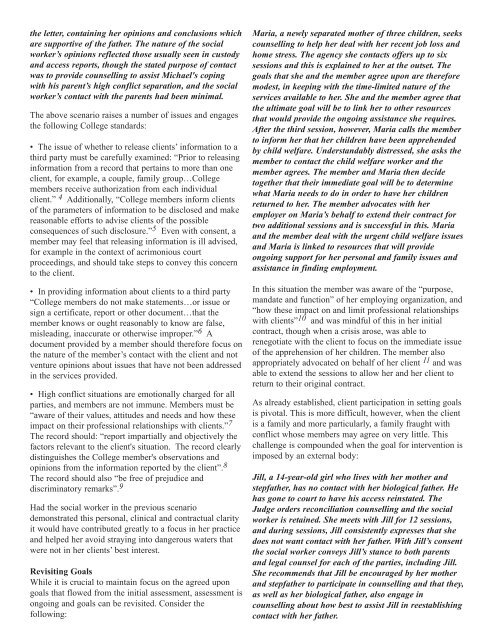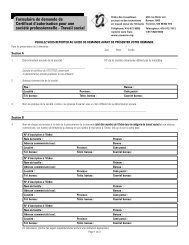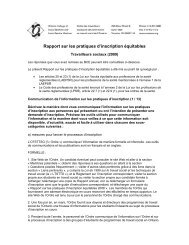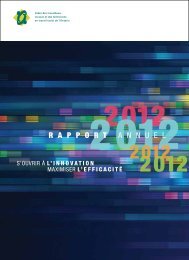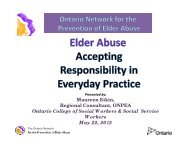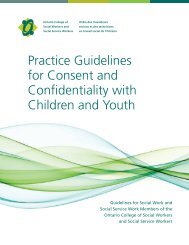Assessment and Goal Setting - Ontario College of Social Workers ...
Assessment and Goal Setting - Ontario College of Social Workers ...
Assessment and Goal Setting - Ontario College of Social Workers ...
You also want an ePaper? Increase the reach of your titles
YUMPU automatically turns print PDFs into web optimized ePapers that Google loves.
the letter, containing her opinions <strong>and</strong> conclusions which<br />
are supportive <strong>of</strong> the father. The nature <strong>of</strong> the social<br />
worker’s opinions reflected those usually seen in custody<br />
<strong>and</strong> access reports, though the stated purpose <strong>of</strong> contact<br />
was to provide counselling to assist Michael's coping<br />
with his parent’s high conflict separation, <strong>and</strong> the social<br />
worker’s contact with the parents had been minimal.<br />
The above scenario raises a number <strong>of</strong> issues <strong>and</strong> engages<br />
the following <strong>College</strong> st<strong>and</strong>ards:<br />
• The issue <strong>of</strong> whether to release clients’ information to a<br />
third party must be carefully examined: “Prior to releasing<br />
information from a record that pertains to more than one<br />
client, for example, a couple, family group…<strong>College</strong><br />
members receive authorization from each individual<br />
client.” 4 Additionally, “<strong>College</strong> members inform clients<br />
<strong>of</strong> the parameters <strong>of</strong> information to be disclosed <strong>and</strong> make<br />
reasonable efforts to advise clients <strong>of</strong> the possible<br />
consequences <strong>of</strong> such disclosure.” 5 Even with consent, a<br />
member may feel that releasing information is ill advised,<br />
for example in the context <strong>of</strong> acrimonious court<br />
proceedings, <strong>and</strong> should take steps to convey this concern<br />
to the client.<br />
• In providing information about clients to a third party<br />
“<strong>College</strong> members do not make statements…or issue or<br />
sign a certificate, report or other document…that the<br />
member knows or ought reasonably to know are false,<br />
misleading, inaccurate or otherwise improper.” 6 A<br />
document provided by a member should therefore focus on<br />
the nature <strong>of</strong> the member’s contact with the client <strong>and</strong> not<br />
venture opinions about issues that have not been addressed<br />
in the services provided.<br />
• High conflict situations are emotionally charged for all<br />
parties, <strong>and</strong> members are not immune. Members must be<br />
“aware <strong>of</strong> their values, attitudes <strong>and</strong> needs <strong>and</strong> how these<br />
impact on their pr<strong>of</strong>essional relationships with clients.” 7<br />
The record should: “report impartially <strong>and</strong> objectively the<br />
factors relevant to the client's situation. The record clearly<br />
distinguishes the <strong>College</strong> member's observations <strong>and</strong><br />
opinions from the information reported by the client”. 8<br />
The record should also “be free <strong>of</strong> prejudice <strong>and</strong><br />
discriminatory remarks”. 9<br />
Had the social worker in the previous scenario<br />
demonstrated this personal, clinical <strong>and</strong> contractual clarity<br />
it would have contributed greatly to a focus in her practice<br />
<strong>and</strong> helped her avoid straying into dangerous waters that<br />
were not in her clients’ best interest.<br />
Revisiting <strong>Goal</strong>s<br />
While it is crucial to maintain focus on the agreed upon<br />
goals that flowed from the initial assessment, assessment is<br />
ongoing <strong>and</strong> goals can be revisited. Consider the<br />
following:<br />
Maria, a newly separated mother <strong>of</strong> three children, seeks<br />
counselling to help her deal with her recent job loss <strong>and</strong><br />
home stress. The agency she contacts <strong>of</strong>fers up to six<br />
sessions <strong>and</strong> this is explained to her at the outset. The<br />
goals that she <strong>and</strong> the member agree upon are therefore<br />
modest, in keeping with the time-limited nature <strong>of</strong> the<br />
services available to her. She <strong>and</strong> the member agree that<br />
the ultimate goal will be to link her to other resources<br />
that would provide the ongoing assistance she requires.<br />
After the third session, however, Maria calls the member<br />
to inform her that her children have been apprehended<br />
by child welfare. Underst<strong>and</strong>ably distressed, she asks the<br />
member to contact the child welfare worker <strong>and</strong> the<br />
member agrees. The member <strong>and</strong> Maria then decide<br />
together that their immediate goal will be to determine<br />
what Maria needs to do in order to have her children<br />
returned to her. The member advocates with her<br />
employer on Maria’s behalf to extend their contract for<br />
two additional sessions <strong>and</strong> is successful in this. Maria<br />
<strong>and</strong> the member deal with the urgent child welfare issues<br />
<strong>and</strong> Maria is linked to resources that will provide<br />
ongoing support for her personal <strong>and</strong> family issues <strong>and</strong><br />
assistance in finding employment.<br />
In this situation the member was aware <strong>of</strong> the “purpose,<br />
m<strong>and</strong>ate <strong>and</strong> function” <strong>of</strong> her employing organization, <strong>and</strong><br />
“how these impact on <strong>and</strong> limit pr<strong>of</strong>essional relationships<br />
with clients” 10 <strong>and</strong> was mindful <strong>of</strong> this in her initial<br />
contract, though when a crisis arose, was able to<br />
renegotiate with the client to focus on the immediate issue<br />
<strong>of</strong> the apprehension <strong>of</strong> her children. The member also<br />
appropriately advocated on behalf <strong>of</strong> her client 11 <strong>and</strong> was<br />
able to extend the sessions to allow her <strong>and</strong> her client to<br />
return to their original contract.<br />
As already established, client participation in setting goals<br />
is pivotal. This is more difficult, however, when the client<br />
is a family <strong>and</strong> more particularly, a family fraught with<br />
conflict whose members may agree on very little. This<br />
challenge is compounded when the goal for intervention is<br />
imposed by an external body:<br />
Jill, a 14-year-old girl who lives with her mother <strong>and</strong><br />
stepfather, has no contact with her biological father. He<br />
has gone to court to have his access reinstated. The<br />
Judge orders reconciliation counselling <strong>and</strong> the social<br />
worker is retained. She meets with Jill for 12 sessions,<br />
<strong>and</strong> during sessions, Jill consistently expresses that she<br />
does not want contact with her father. With Jill’s consent<br />
the social worker conveys Jill’s stance to both parents<br />
<strong>and</strong> legal counsel for each <strong>of</strong> the parties, including Jill.<br />
She recommends that Jill be encouraged by her mother<br />
<strong>and</strong> stepfather to participate in counselling <strong>and</strong> that they,<br />
as well as her biological father, also engage in<br />
counselling about how best to assist Jill in reestablishing<br />
contact with her father.


